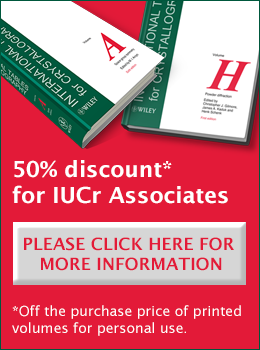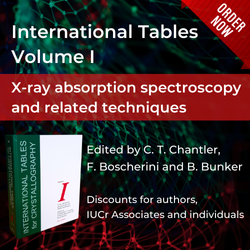
Editorial
Editorial
![Thumbnail [Thumbnail]](https://www.iucr.org/__data/assets/image/0010/158878/LogoanimationNewsletter.gif)
The IUCr Newsletter has developed its personality over the last few years, starting as a paper journal distributed to crystallographers and others worldwide and becoming the current online journal. As editor of the Newsletter, I have been lucky to receive enormous help from the IUCr staff at Chester (UK), especially from Andrea Sharpe, the Promotions Officer. Without her hard work, the Newsletter would never have become the success it is today. But time marches on, and Andrea is now retiring from the IUCr, and I shall be sorry to see her go. Let me take this opportunity to express my personal gratitude and thanks for her support over the last few years.
Another loss to the IUCr is Michele Zema, who left at the end of May. Michele performed the task as a kind of ambassador for the IUCr and worked tirelessly to spread crystallography worldwide. For example, in this issue, we have several articles in the Crystallography in Africa category, for which Michele played a significant role:
- Bridging continents through crystallography: how AFRAMED is revolutionising scientific collaboration in Africa by Rim Benali-Cherif and Eric Ziki
- Bringing crystallography to the classroom: Kenyan teachers learn to engage students in the wonders of crystals by Patricia W. Gitari and Martin N. Mbugua
- First Senegalese Day of Crystallography by Magatte Camara, Ibrahima Elhadji Thiam, Rokhaya Sylla Gueye, Mbossé Ndiaye Gueye, Adama Sy, Farba Bouyagui Tamboura, Emmanuel Wenger and Claude Lecomte
- Foreword to the AfCA collection: Celebrating work published by African researchers in IUCr journals by Susan A. Bourne, Delia A. Haynes and Michele Zema
![[Fig. 1]](https://www.iucr.org/__data/assets/image/0009/158859/Fig.-1.jpg)
And then there is Peter Strickland, Executive Managing Editor of the IUCr, who is about to retire. I have known Peter ever since he joined and have always been impressed by his knowledge, devotion to the IUCr and his profound ability in managing the production of our journals. I think it will be difficult to find a replacement, and I am sorry to see him go.
I am also grateful to the Hargittais, who have constantly supplied us with fascinating articles for each issue. This time, there are two articles: one on aperiodic crystals and the other on the Berlin Natural History Museum, and the scientists and crystallographers celebrated there. I have a personal interest in the history of crystallography, and I welcome these contributions. I hope you too find them interesting.
In this issue, several reports from around the world illustrate how vibrant our subject is after such a long history. This history goes back hundreds of years, possibly thousands (see https://www.iucr.org/news/newsletter/volume-26/number-2/wrestling-with-questions-at-the-edge-of-science-methods). Crystallography can be seen to be developing well in Africa (see above) and in places like Thailand.
One of my sad tasks in each issue is the need to publish obituaries, often of people I have known for years. This time, Stephen Tarling and Larry Finger were both well known within the crystallography community. Larry was a genius who revolutionised the use of computers in our subject. Crystallographic research relies heavily on the use of software and computer-aided equipment. Today, such tools have become commonplace, so much so that many crystallographers are unaware of the science behind their automatic machines. Larry worked before such automation existed and built a computer that became the mainstay for many crystallographic laboratories worldwide. He even built the PDP11 and Microvax computers used for the beamlines at the Brookhaven synchrotron light source from spare parts.
Stephen Tarling was a clever researcher with an engaging and somewhat eccentric sense of humour. As such, he was always a pleasure to work with. My interactions with him were mainly through working with him as expert witnesses in patent litigations (in one case, we came up on opposite sides!). These were court cases, mainly in the USA, in which the financial stakes were very high, and, as a result, arguments in court could often be fraught and bad-tempered. When confronted by some of the most highly paid and artful lawyers, one had to develop a thick skin to stand up to aggressive examination. The first of these cases was on an antibiotic called cephadroxyl monohydrate. The main item of contention related to the argument that the crystal structure of this material, prepared initially under a lapsed patent, was no longer possible to obtain. Instead, a new form was developed and covered by a new patent. The argument was exceedingly complex, and I can’t provide details here. But, this was, I believe, one of the first cases where the subject of “disappearing polymorphs” was raised. This is where the crystal structure of a pharmaceutical, for some reason, changes, and one is subsequently not able to recover the original structure. There were many anecdotes of such peculiar behaviour in the literature, but none had been proven. Below, for your entertainment, I attach a screen image of a paper published in 1975 in the Journal of Applied Crystallography by Woodard and McCrone, in which many unusual and intriguing examples are described.
![[Fig. 2]](https://www.iucr.org/__data/assets/image/0010/158860/Fig.-2.jpg)
When Stephen and I first became involved, the idea seemed so unlikely, but as the case evolved, the evidence for it became firmer. At one stage, I recall a long discussion in court and with lawyers about the so-called seeding hypothesis, in which seeds of crystallisation are spread around the world: I recall a discussion on the last breath of Henry VIII! I also was grilled for roughly an hour by a particularly aggressive and feared lawyer about whether two powder diffraction experiments could result in an exact match in the diffraction patterns. I maintained that it was impossible to be exactly the same, but this meant holding out under an intense barrage of questioning. Funnily enough, this same lawyer approached me at the end of the day, shook my hand and told me how much he had enjoyed the argument. At a later stage, I received a phial from the Organic Chemistry Department in Oxford containing a liquid with crystals at the bottom. X-ray diffraction suggested that the material was of the old form. But also very quickly, new crystals formed on the surface of the liquid, which were of the new form. This established that such weird phenomena can and do occur, and today, the idea of the so-called “disappearing polymorphs” is now more accepted. Stephen and I flew back and forth (sometimes on Concorde!) to the USA, and we had a great time together. I am sorry to hear of his demise.
News has reached us of the recent deaths of two other stalwarts of the crystallography community, Richard Pauptit and Dieter Schwarzenbach. Their obituaries are included in this issue.
Copyright © - All Rights Reserved - International Union of Crystallography








